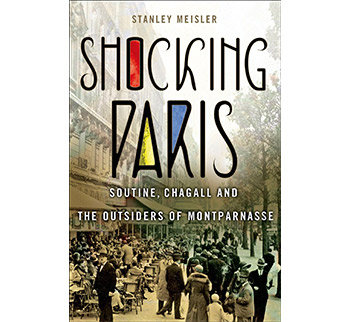There is an achingly poignant, telling moment in Shocking Paris, when Gerda Michaelis Groth – a young refugee who had sought sanctuary in France from Germany’s ruling Nazis – recalls the anxious, tense days prior to the outbreak of World War II.
She and the tempestuous, moody painter Chaim Soutine were in love, living in the idyllic, sylvan splendour far south of Paris near Civry-sur-Surein. Gerda was attempting to restore Soutine to full health from severely debilitating stomach ulcers. Through the powerfully recuperative combination of her tender ministrations, fresh country air and the uncluttered, quiet, calm nature of their lives in the green and gold countryside, Soutine started to heal.
“Soutine and I lived from day to day, enjoying the hours that flowed, the pleasure of being together, the sweetness of precarious happiness. [My emphasis] We had willingly abolished our past, and we closed our eyes on the future.”
In this one precious nugget of paradox – the sweetness of precarious happiness – Gerda conveys the compressed truth of Stanley Meisler’s book.
Meisler has written an instructive, thoughtful book about the group of mostly Jewish immigrant artists who moved to Paris in the early decades of the last century. They and their collective works became known as the School of Paris despite the fact, as Meisler writes, “they were not a school or a movement in the usual sense. They did not try to produce a certain kind of art. Nor can an art historian discern one characteristic or another that defined them. They were simply a phenomenon of history.”
It is, of course, this tumultuous and ultimately murderous period of history that lends the touching effect to the phrase: “the sweetness of precarious happiness.”
The artists who comprised the School of Paris wildly succeeded in the personal development of their own art and in the advancement of modern painting. But France was not very gracious in accepting them – this dynamic, high-energy group of foreign-born painters. Indeed, it is the reaction of the Parisians to the immigrant artists’ success that provides the title to Meisler’s book. “The foreign-born immigrant painters in Paris in the 1920s and 1930s made an impact on the history of art before most Parisians realized they were there. When Parisians did realize it, they were shocked that so much of their cherished world of painting was now in the hands of immigrants.”
Meisler observes, “the Jewish character of the school of Paris provoked the most puzzlement and comment and rancor in the city.” Thus, when the Nazis conquered France in 1940, many of those same Parisians who had expressed resentment over the presence of the foreign-born artists, joined in the sordid effort of ridding the country of these unwelcome immigrants, the mostly Yiddish-speaking, Jewish painters of the School of Paris.
Thus, despite the happiness engendered by their success as artists, they all stood on the edge of a very precarious precipice.
Meisler examines Paris during the period of the first four decades of the 20th century in great detail. This examination takes place on three distinct levels. On the first level, Meisler researches a handful of artists who typified for him the School of Paris: Chaim Soutine, Amedeo Modigliani and Marc Chagall. Meisler reserves the largest treatment for Soutine, because, as we find out in the book’s introduction, Soutine was distant family to the author and the magnet that attracted Meisler to writing the story in the first place.
The second level of analysis is a wide-ranging, seminar-like discourse on the School of Paris itself. Some art historians count as many as 77 painters among the group. Meisler focuses primarily, as mentioned, on Soutine, Modigliani and Chagall but also frequently refers to Jules Pascin (Pincas), Moise Kisling, Ossip Zadkine, Jacques Lipchitz, Michel Kikoine, Chana Orloff , Emmanuel Mané-Katz and Pinchus Krémegne. The book is rich in edifying detail about these artists and their exceptionally evocative art.
The third and most compelling level of Meisler’s exploration is the constant motif of the artists’ outsider status. It courses through the work and culminates in the sorrowful depiction of the fevered efforts by the painters to escape the genocidal grasp of the Nazis and their Vichy accomplices and of the remarkable courage of a few caring others who helped bring about the rescue of some of the artists.
Shocking Paris is an excellent work. It is far more than a literary presentation of the “turmoil, exuberance and pulsating power” of Soutine’s paintings, or of the “universal nobility” of Modigliani’s subjects or the “deep colours and surreal dreaminess” of Chagall’s paintings. At its core, it is a tightly told tale of the flowering of immigrant and especially Jewish immigrant spirit, energy, drive, single-mindedness of purpose and brazen creative power despite an environment that was often hostile and ultimately toxic.
* * *
For additional insight into the turbulent Paris of the first half of the 20th century, I recommend Léon Blum, Prime Minister, Socialist, Zionist by Pierre Birnbaum, professor emeritus at the Sorbonne (Yale University Press, 2015).
Fastidiously researched – each page densely loaded with information and anecdotes that are supported by some 40 pages of footnotes – Birnbaum mines the rich veins of myriad archival documents to paint a richly detailed portrait of the remarkable man who stood his principled, moral ground against horrific personal vilification, waves of thuggish political violence, grotesque anti-Jewish hatred, Vichy betrayal and Nazi brutality.
Blum, the improbable prime minister of France in 1936, was the strong-willed and resolute socialist leader of a left-wing coalition of disparate parties. He was a lightning rod for the reactionary forces that would soon transmogrify into the monstrous supporters of Hitlerian fascists and Pétainist collaborators.
Birnbaum paints his portrait of Léon Blum with specifically Jewish brush stokes, time and again highlighting how Blum’s Jewish identity was central to all aspects of the man’s personality, politics and private and public loyalties.
